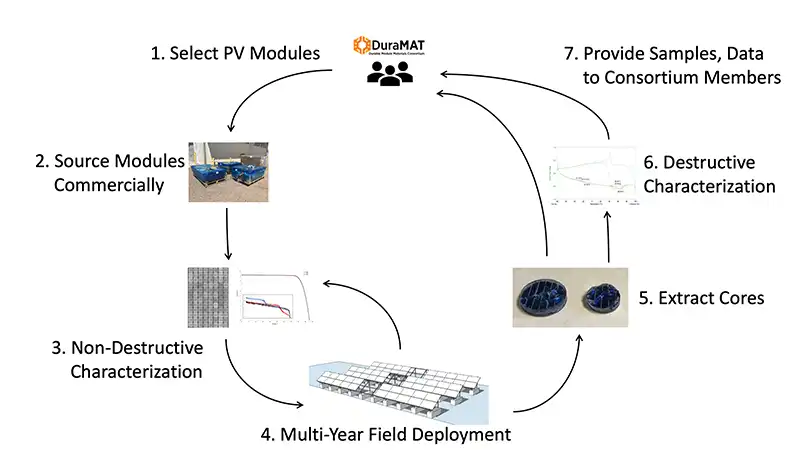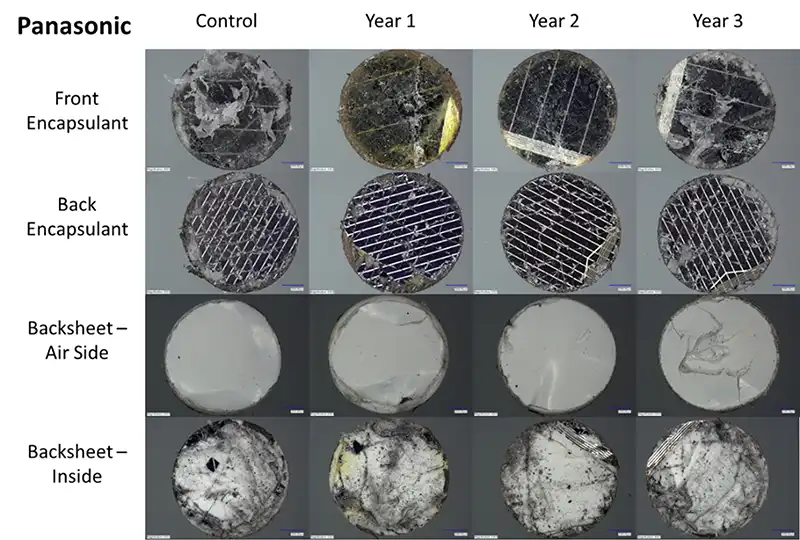DuraMAT Fielded Module Library
DuraMAT will output a set of photovoltaic (PV) module material samples distributed across a range of manufacturers and field exposure times.
The rapid technical evolution and market expansion of PV modules creates uncertainty around long-term materials durability. Most PV degradation studies focus on measuring changes in electrical output over time in the field or after accelerated testing, whereas material degradation processes likely begin before electrical impacts are seen. For this project, we addressed this by characterizing and fielding commercially sourced modules from top ranked manufacturers. Single modules from each module type were retrieved from the field annually for destructive testing to quantify material stack degradation processes.
This project was conducted in coordination with the separate PV Lifetime project. These two projects are complementary as the Field Module Library project added a strong materials science component that is missing from PV Lifetime. In turn, the Field Module Library benefitted from detailed system performance data available from PV Lifetime. The combination of the two will be globally unique in a publicly available data set.
Core Objective
Location
Sandia National Labs
Applications
This capability primarily will provide material samples for laboratory analysis to validate bills of materials and materials degradation. Fielded modules will be available to researchers exploring nondestructive module forensics. Field measurements can be compared to laboratory measurements from core samples for validation. Materials degradation information can be combined with on-site weather, periodic electrical performance measurements, and PV Lifetime system power data to support machine learning or other advanced analytical methods applied to inhomogeneous data.
Availability
This resource is available to DuraMAT Consortium members, members of the Industry Advisory Board, and third-party project awardees.
References
[1] Joshua S. Stein, Charles Robinson, Bruce King, Chris Deline, Steve Rummel and Bill Sekulic, “PV Lifetime Project: Measuring PV Module Performance Degradation: 2018 Indoor Flash Testing Results,” 7th World Conference on Photovoltaic Energy Conversion (WCPEC-7), Waikoloa, HI, 2018.
[2] H. R. Moutinho, et. al, “Development of coring procedures applied to Si, CdTe and CIGS solar panels,” Solar Energy, 161, pp 235-241, 2018. https://doi.org/10.1016/j.solener.2017.11.071
[3] D. L. King, M. A. Quintana, J. A. Kratochvil, D. E. Ellibee and B. R. Hansen, Photovoltaic Module Performance Following Long-Term Field Exposure, AIP Conference Proceedings, 462, 565, 1999. https://doi.org/10.1063/1.58001
Contact
To learn more about this capability, contact Bruce King.

Figure 1. Project overview

Figure 2. Core samples are extracted as a complete material stack using a modified CNC table and diamond core drill. Samples are carefully split by hand to expose individual material layers and perform further benchtop characterization such as differential scanning calorimetry and Fourier-transform infrared spectroscopy.